Longhorns’ Most Invaluable UT Objects and Their Heartfelt Stories
Most everyone who attended The University of Texas has a boatload of school spirit and the tendency to end phone calls with a quick “hook ’em!” instead of “goodbye.” Often that strong affinity can be seen manifested in the temporal sense, through totems and talismans—treasured objects thought to bring their owner good luck—as common as a trusty Texas water bottle or a pair of well-worn burnt-orange socks. For others, memories are passed down through the generations via the most vintage of items—like old letter jackets, custom jewelry, and handmade clothing—that scream Texas pride. Some hold onto history in the form of 1930s-era football letter blankets and felt armbands worn by students just a few decades after the university’s founding in 1883. We asked alumni to open their keepsake boxes and share stories of their most beloved mementos from their days on the Forty Acres. From a championship ring compendium so vast its owner aims to open a museum, to a custom-made Longhorn belt buckle and a whole load of lucky hoodies and Texas caps, the response was overwhelming, as though all of Longhorn Nation was just waiting to be asked. Here are a few of the heartwarming and unique objects of note y’all have kept close.
2005 National Championship Football Team Russian Nesting Dolls, Hand-Painted.

Christina Rios, BS ’08, lives in Atlanta these days, but her alma mater is no secret to anyone she regularly encounters—she wears Texas-shaped stud earrings, Longhorn sunglasses, and burnt-orange T-shirts daily. Out of all her keepsakes though, the most eye-catching is her set of Russian nesting dolls that sit on a bookshelf in her guest room, stealing the limelight from a giant plush Longhorn, Texas bottle light, and until his recent move to an outdoor flower bed, a UT garden gnome. The dolls are hand-painted in the likeness of five players from the 2005 National Championship football team: Vince Young, Ramonce Taylor, David Thomas, Jamaal Charles, and Henry Melton. Rios’ father bought them for her on a business trip in 2006.
“When he saw this Longhorn set in Russia, he was pretty surprised! I’m sure it made him feel proud that his child (the first college graduate among his immediate family, parents, siblings, nieces, and nephews) was attending a university recognized around the world,” Rios says.
“When I look at this set, I’m reminded of my hardworking dad who afforded me the opportunity to attend The University of Texas and the lasting friendships and memories I made while there.”
Custom-Made Gold and Diamond UT Rings, Worn To Every Home Game For At Least Two Decades. Now Worn In Memoriam.
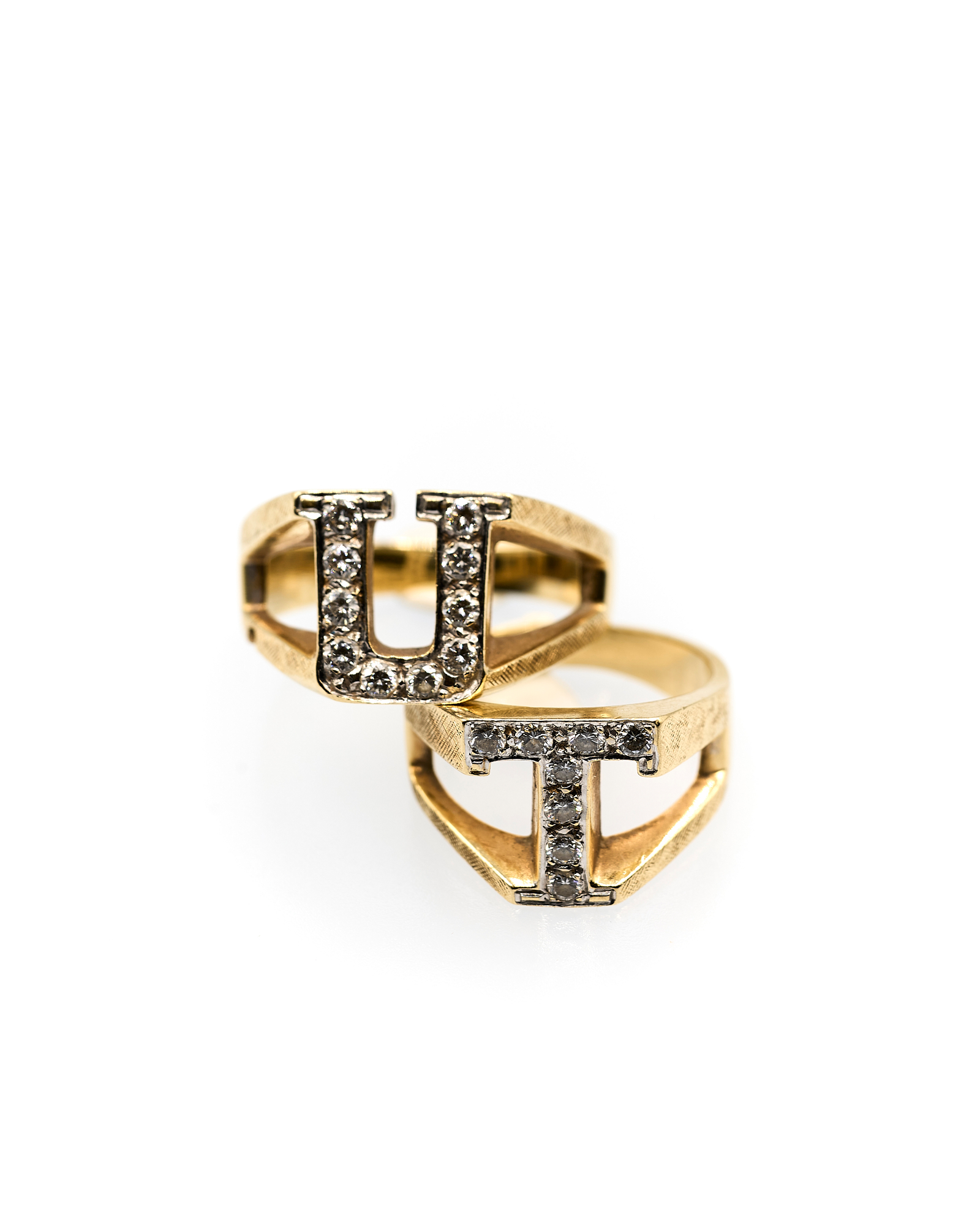
Cristen Carey Daniel’s custom-made UT rings are her most prized possession from her mother. A gold-accented diamond “U” that’s worn on the index finger, and a “T” for the pinky, they’re perfect for posing in photos while flashing the hook ’em hand sign. They also hold tremendous sentimental value for Daniel, BS ’97, who inherited the rings after her mother, father, sister, brother-in-law, and nephew died in the devastating 2015 Wimberley flood.
Daniel’s father had them custom made for her mom as a gift, most likely for their November anniversary, in the late ’80s or early ’90s, and they were the perfect accent to her flamboyant style and personality.
A flight attendant and model for Braniff Airlines in the 1960s, Daniel’s mother had a distinct style. “Everybody loved it,” Daniel says. “She just owned it and did what she wanted to do.”
The Careys never missed a home game, and their tailgate parties were inclusive, get-down affairs. Daniel’s mother would always be decked out in Texas jewelry and head-to-toe orange and white. Since her parents died, Daniel has carried on the tradition of wearing the UT rings to every game she attends.
Needlepoint Scene of a Hellraiser Preparing for Gameday, Private Collection.

Dickie Johnson, BS ’79, loves needlepoint art so much that he often rises at 4 a.m. to get a little embroidering in before leaving for work. He has been practicing needlepoint since he was an undergrad studying civil engineering, and has made dozens of pieces over the years, mostly re-creations of photos of his children and grandchildren.
One of his most striking works is a framed petit point of his son, Ethan Johnson, BS ’15, a member of the Longhorn Hellraisers, where he earned the position of “X.” It’s a re-creation of a photo taken of Ethan during his junior year, getting ready for a football game. In it, his face is serious as he stares into the distance, with long hair flowing down behind him, while a woman paints his chest with the Texas “X;” the Tower—an addition his wife suggested to give it more UT flair—can be seen in the background.
It was an intricate process. Dickie used a pixelated photograph and autoCAD to create the layout on a blank canvas. Each of the dots is 1/20th of an inch apart, and the whole thing consists of approximately 32,000 stitches. Ethan will inherit the piece someday, but for now, Dickie keeps it in his Wellington kitchen to appreciate and enjoy every day.
Dried Out 2006 Rose Bowl Turf, Framed.

After the Longhorns won the 2006 Rose Bowl—a victory that wasn’t procured until the last 19 seconds of the game, by quarterback Vince Young—and received their trophies, Quan C.M. Tran, BS ’03, Life Member, and his friends waded through confetti down to the field from their seats in the USC end zone. There was a joyous cacophony of people celebrating while the band played, the air crisp and cool, but with a weighty dampness to it. “It was all rather surreal, you just felt like anything was possible after experiencing that game,” Tran says.
They wanted to take it all in, memorize the moment. That’s when a spontaneous thought occurred to Tran. He asked security if he could grab a piece of turf to keep as a memento. “They said, ‘Sure, just be quick.’ So, I stuck history in my back pocket for the remainder of the night,” he says.
That chunk of turf, now encased in a frame and foregrounding a photo of Tran beaming on the field, has long since wilted and dried, but it represents something even more meaningful than a championship win.
When Tran went to UT, he lived with a few guys he grew up with in Houston, mostly immigrant kids like himself. That’s who he went to Pasadena with for that historic game—one that some consider the greatest college football game ever—paying about $600 for tickets, a huge expense for the young professionals.
For at least a decade after, the friends maintained the email thread they’d used to plan the trip, keeping in touch through moves, marriages, career changes, and kids. Eventually, they migrated to a messaging app, where they still talk regularly. They have season tickets and always sit together at games. This one moment created that opportunity, and Tran and his friends used it to become closer.
Men’s Burnt-Orange Gingham Button-down Shirt. Worn On A First Date, Reimagined As A Baby’s Onesie.
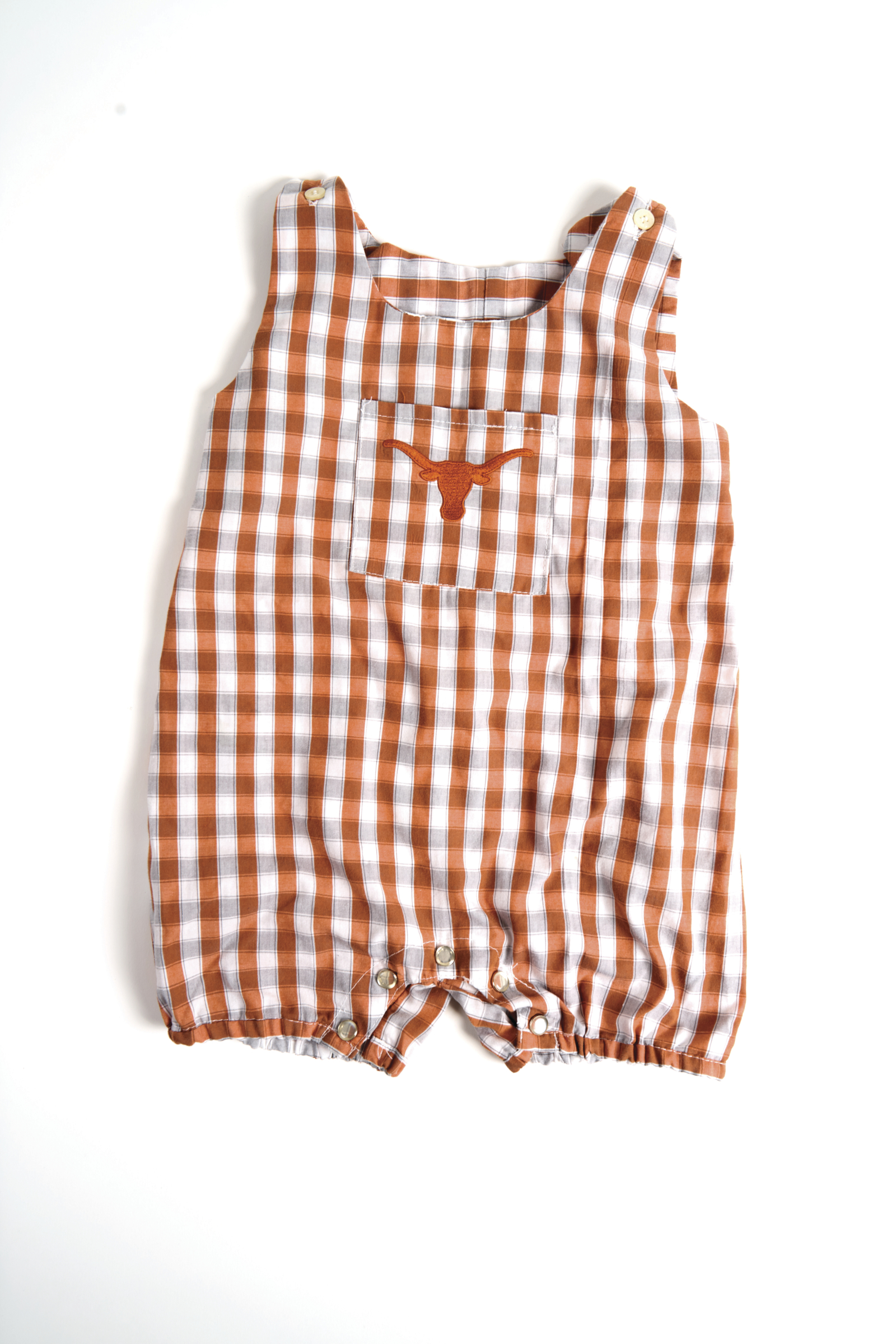
Samantha Maldonado Ramirez, BS ’15, Life Member, and her husband, Rudy Ramirez, BA ’08, are first-generation college graduates, a fact they’re both proud of. It’s a large part of what makes their connection to UT so meaningful, and is one of the reasons Ramirez came back to the Rio Grande Valley to become a teacher (now principal)—to inspire others who might become the first in their families to attend college, too. When Maldonado returned home to South Texas with her communications degree in 2015, she wanted to stay involved, so she joined the Texas Exes Brownsville Chapter. At a watch party for the 2016 season opener against Notre Dame, Maldonado noticed her future husband immediately. The pair were some of the youngest attendees. They made plans to sit together at the next watch party, but when it was canceled, they met up anyway and hit it off.
Ramirez was wearing his favorite UT button-down shirt on that first date, and as their romance blossomed, the garment took on new meaning. They considered the shirt their lucky charm. After their wedding, they got pregnant with their first child. The announcement they sent to family and friends featured all the requisite burnt-orange details, “and of course, my husband’s button down,” Maldonado says.
“Growing up our families did not really have items that would be passed down throughout the years, so when our son John turned one, we knew just what to do. We had my husband’s button down turned into a one-of-a-kind outfit for John to wear to his first birthday party.” It’s a burnt-orange gingham onesie that they plan to pass along to their daughter, who arrived at the start of football season.
Vintage UT Letter Sweater Collection, Mostly Rehabilitated, Patched, and Sewn By a Dallas Fashion Designer.
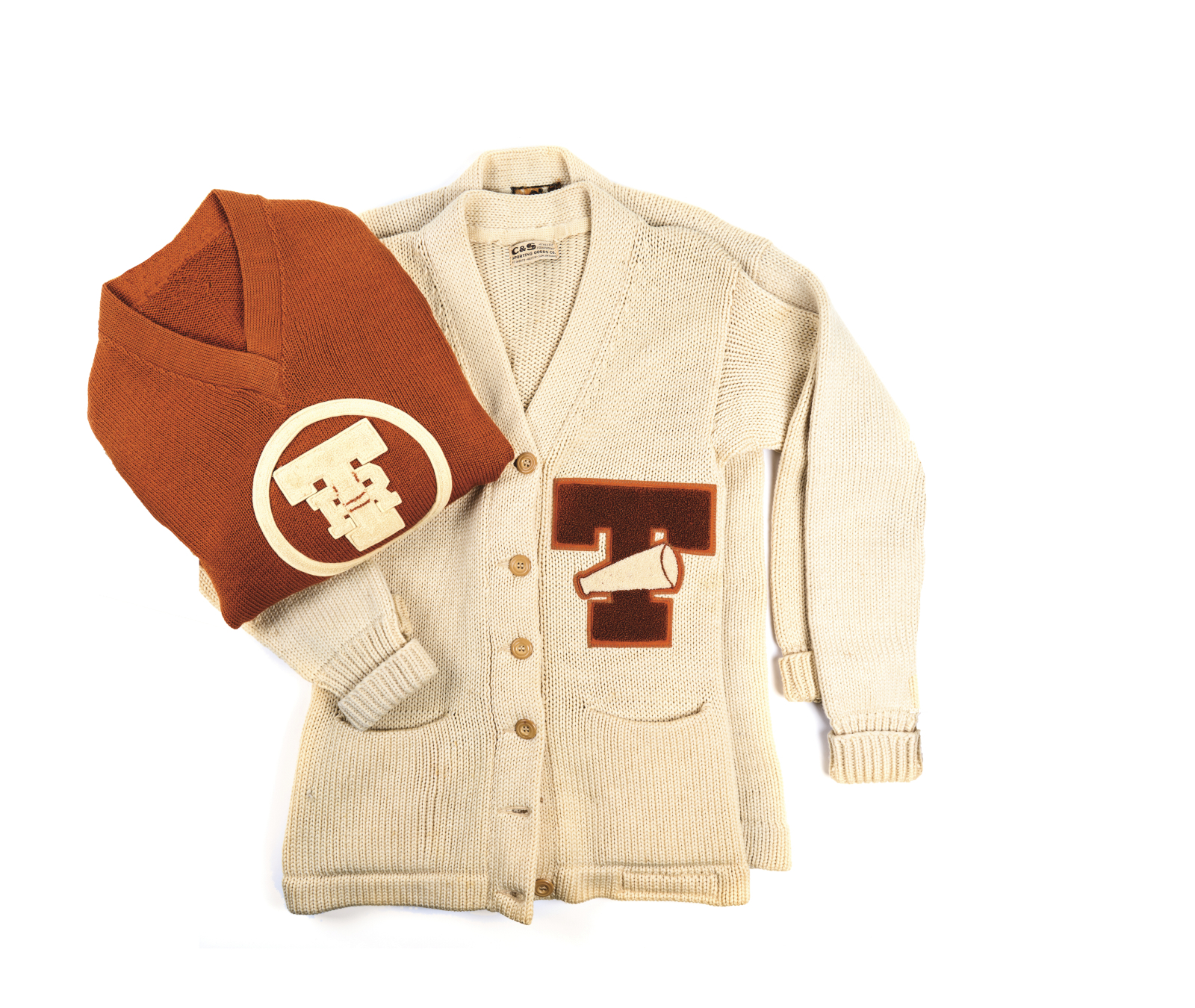
You may have seen Leon Bridges rocking one of these vintage letter sweaters on tour, or Donald Glover wearing one in a music video. Lena Dunham can be seen in one on an episode of Girls, and they’ve been displayed in the pages of Playboy, GQ, and Vogue Italia. But you can’t find those pieces in a store. They’re one-of-a-kind items, sourced and created by Dallas-based designer Eric Renteria, ’00.
When he enrolled at Texas Tech for graduate school, Renteria had already amassed a small personal collection of old letter sweaters. He was 34 and felt like he stood out from a younger-skewing crowd on campus. His unique Texas letter sweater from the 1940s distinguished him further. He wore it all the time, and people started noticing; they’d ask to take photos with him. The school newspaper even interviewed Renteria to find out what the deal was with that guy in the cool sweater. So many people were interested, he started making and selling vintage letter sweaters by request. He finds original sweaters and then adds old patches or other details.
That was, until he received a cease-and-desist letter from UT. Now he just makes and gifts them to people he knows will appreciate his work and the history behind each piece.
He’s become an expert at mending wool and knows his way around a sewing machine. Each original sweater has the owner’s name chain-stitched onto it; Renteria researches them and passes on their story to the item’s next owner. Sometimes people send him keepsake sweaters and jackets because they think he’ll make better use of them than they could themselves. He has a closet full of vintage Texas wear, including one sweater that belonged to a Longhorn cheerleader who went on to become Miss Texas 1949 and a Miss USA contestant.
Black Velvet Painting, Depicting the Tower lit in burnt orange after the 1969 National Championship win against Arkansas. Made by a Buddhist monk in Thailand, Circa 1969.
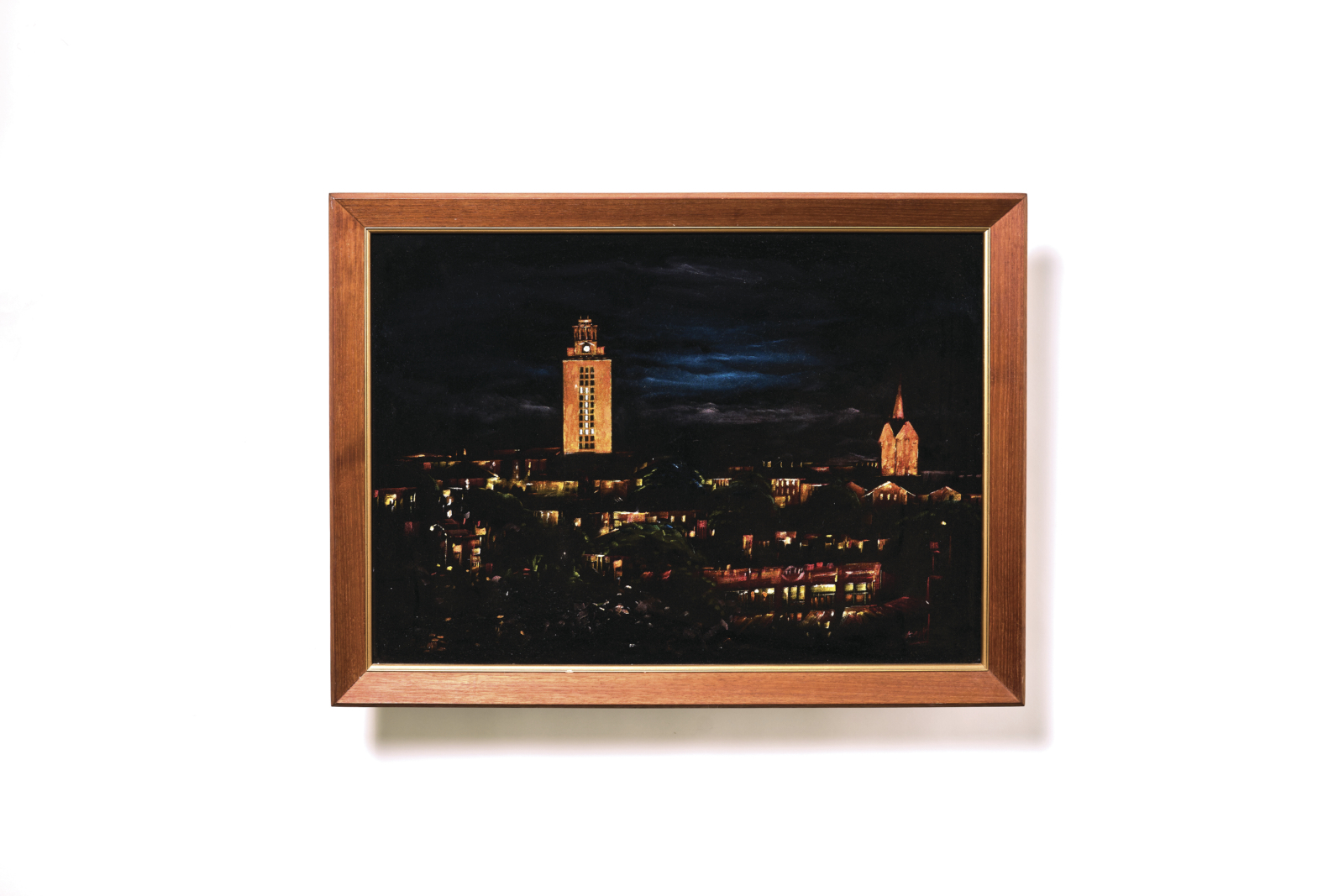
Nowadays, velvet paintings may be considered kitsch, but the ancient technique was popular in 1950s Thailand, where James Burwell Fisher was based while in the Air Force. Buddhist monks sold their artwork outside Fisher’s base and he commissioned a painting there. His wife was living in the Greenwood Apartments on Lavaca Street around the time of the 1969 National Championship, and as family legend has it, she took a photo of the Tower lit orange when Texas beat Arkansas. She sent the photo to her husband, and he took the photo to a monk and asked him to re-create the scene.
The painting prominently features an orange church, a sacred color in Buddhism. The monk insisted that the church needed to be big, and it needed to be orange.
“This painting hung in their house for years,” one of the Fisher’s adult grandchildren, Jay, BA ’98, says. “I always admired it. I would stare at it and imagine going to school there.” He ended up attending UT, along with his brothers Daniel, BBA ’95, and Jonathan, BS ’98; their father and aunt were Longhorns too. When Dan was an undergrad, he would spend weekends at his grandparents’ place on Lake LBJ, studying in the basement at a little desk where the luminescent painting hung on the wall. It now hangs in the bedroom of Jay’s youngest son.
T-Shirt Quilt, Made With Love, Chock-full of 1980s Longhorn Band Mementos. Frequently Used, But in Pristine Condition.
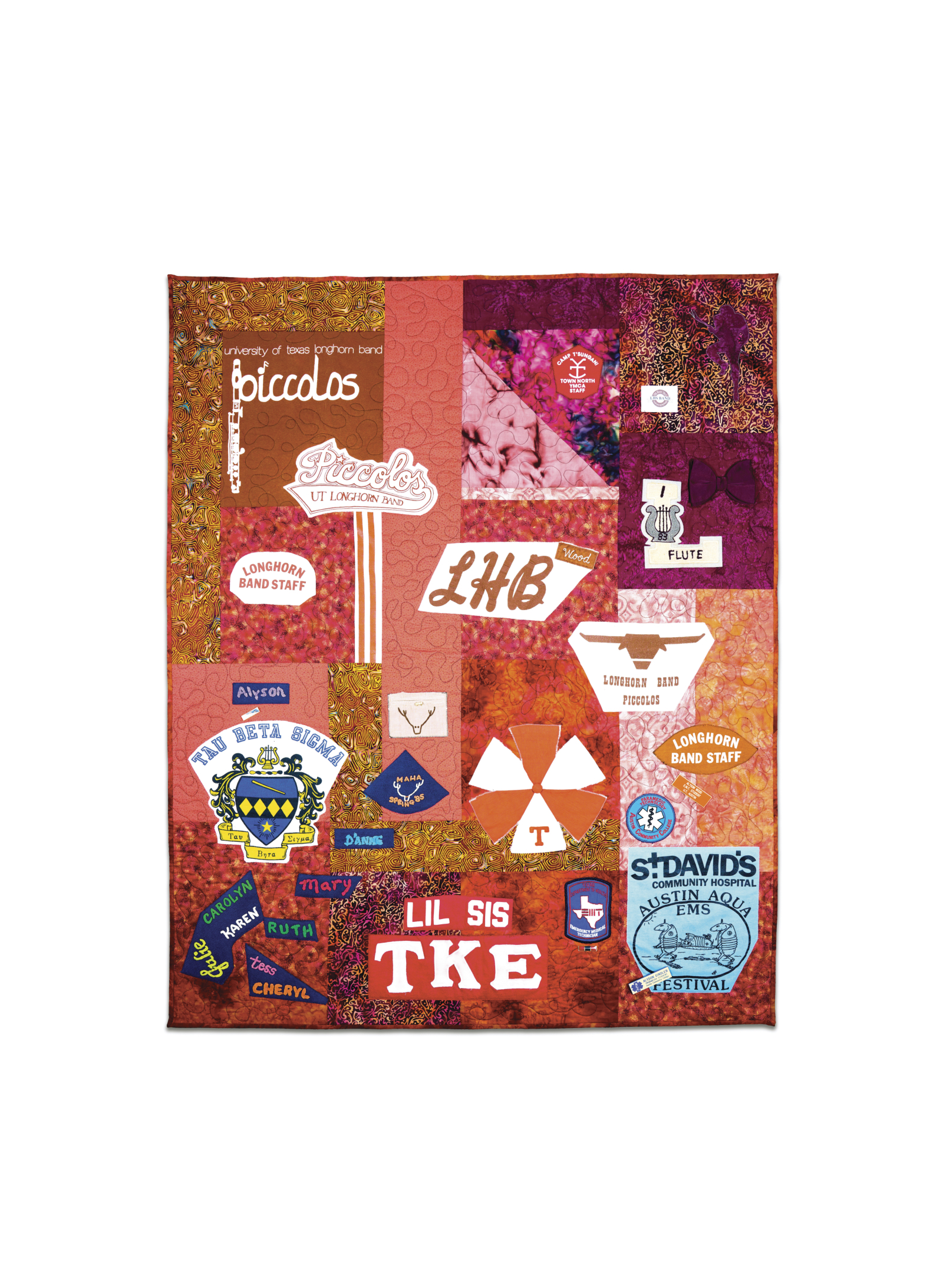
Alyson Gindler’s T-shirt quilt isn’t your average collection of graphics interspersed with plain fabrics. Her mother, a talented seamstress who has sewn costumes for play productions, handmade a unique memory quilt for Gindler, BA ’87, after years of hemming and hawing over what to do with her surplus of college memorabilia. “When I talked with my mother about it, she suggested I let her put something together for me that would allow me not only to keep it but to proudly display some of my fondest memories,” Gindler says.
On it are shirts and patches from her time in the Longhorn Band, as well as puff-painted names of her sisters from a service sorority associated with the band, and even her freshman beanie, splayed open on the quilt to unique effect. (It was a tradition that freshmen wore beanies at all times during official band functions and when on the grounds of the music building.)
After completing an EMT certification course at Bellmont Hall her senior year, Gindler volunteered as an EMT at Aqua Fest. It was the beginning of her career as a nurse; the T-shirt representing that chapter is in the bottom right corner.
“Every time I look at this quilt,” she says, “I am reminded of all of the fun, friends, and memories that I was blessed to have while attending The University of Texas!”
Big XII Championship Sweatshirt, Acquired 1996, JanSport, Size XL.

In December 1996, UT sophomore Jill Greenwell, BA ’99, was taking a final exam as a six-alarm fire blazed through the West Campus Centennial apartment complex she’d just moved into. Greenwell was excited about having her first apartment; her parents’ home was being remodeled, and she’d just acquired some household items they didn’t want or need anymore.
She lost everything in the fire. So, when she returned to school the next semester and the Co-op offered a free backpack and shirt to students affected by the disaster, “I wasted no time getting there,” Greenwell says. “The shirts we could pick from came from a sales rack and I picked an XL JanSport sweatshirt that looked to me the best of the lot. It was the 1996 Big XII Champions shirt. Long story short, 25 years later and this is my most beloved [piece of] loungewear. I plan on having this sweatshirt ’til I die. I’m pretty sure it will outlast me!”
1990s-Era Texas Cheer Uniforms, Fringed and Fitted, Not Yet Retired.
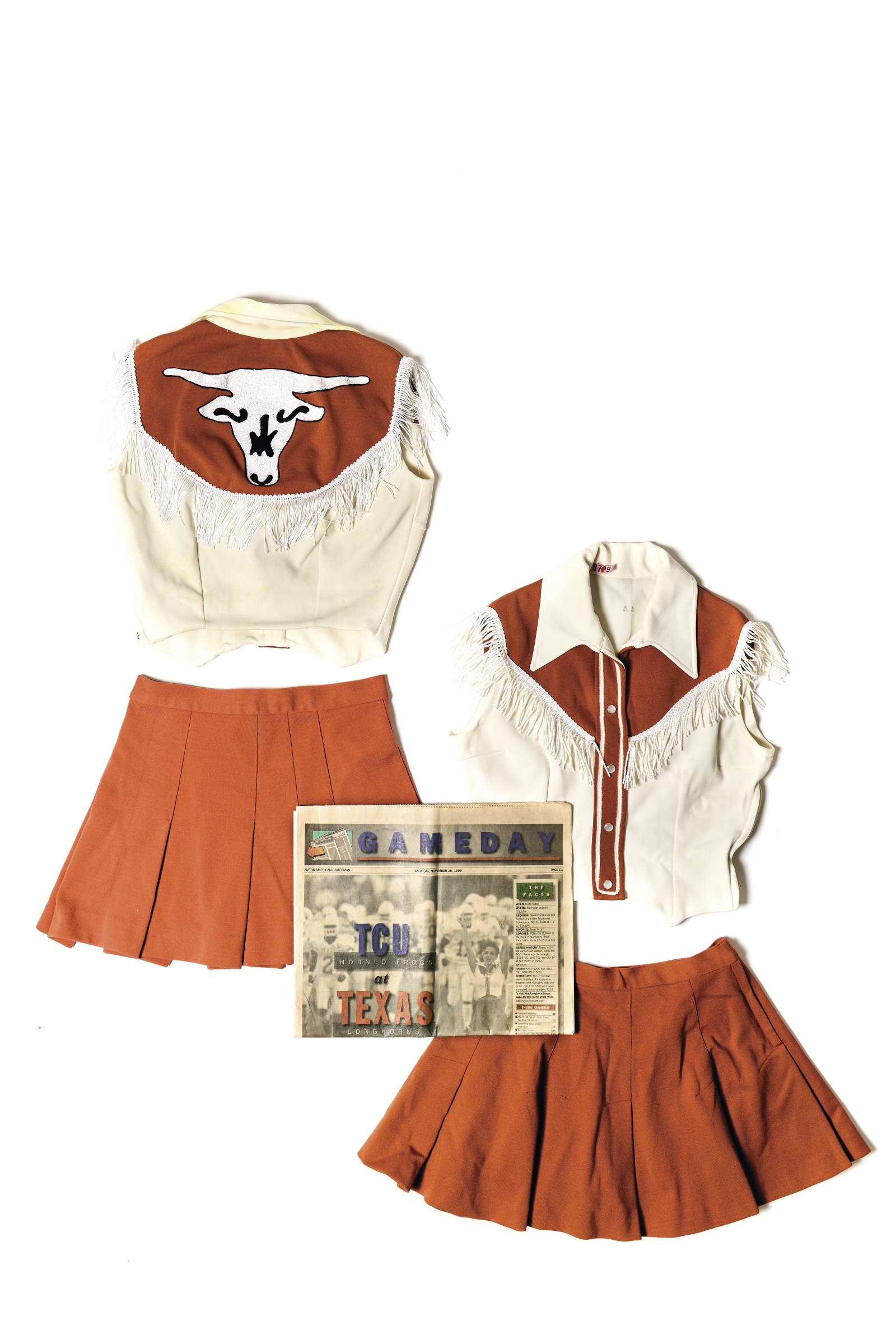
Aly Calvo, BA ’96, Life Member, and Andrea Kulberg, BS ’95, are identical twins who were Texas cheerleaders in the early ’90s, and their uniforms—fringe and all—still fit all these years later. They even don them every other year for a cheerleading reunion game.
Together they run a company that hosts cheerleading and dance competitions in the United Kingdom and an offshoot business coaching people in the sports world on leadership and personal development. They share with young athletes the ethos that their coach instilled in them at Texas; the message is so influential that in photos, their cheerleaders across the pond can be seen throwing up their horns.
The sisters first started cheering in junior high. Sitting around the lunch table discussing who wanted to try out for the team, Calvo said she was planning on it, and Kulberg said she would as well. A bully told Kulberg she couldn’t try out because of her visual impairment, but she proved her wrong.
“I had a decision to make at that point to kind of believe the naysayers and believe what society says a disabled person should be or a legally blind person should be, or do I want to just do things on my terms?” Kulberg says.
The Daily Texan “T-and-Quill” Medal, Awarded To The “Best Assistant issue Editor” of 1926. Now Worn As A Necklace By The Recipient’s Great-Granddaughter.

Melissa Reese, BJ, BS ’10, spent the majority of her time at UT studying film. But when she was nearly finished with her RTF degree, Reese, almost on a lark, tacked on a journalism degree, which she could complete by the end of her fourth year. She was partially inspired to do so by her late great-grandmother, Dorothy Louise Harris, who studied journalism at UT and graduated in 1926.
One of her most prized possessions is her grandmother’s silver pendant from 1926 that features a Longhorn, the letter “T,” and a quill pen. It’s called a “T-and-Quill Medal,” and was awarded to Harris by her colleagues at The Daily Texan in the category of “best assistant issue editor.” Harris went on to be an editor at a newspaper in Quanah, Texas, and though she mostly stopped writing after starting her family, in her heyday, Harris was well liked and respected by her journalism peers. One wrote in her yearbook, “You’re one of the best seamstresses I know, even with paper.” Reese always looked up to her “Great Mama” when she was growing up in Dallas and felt connected by their shared sense of curiosity and love of crafting and making.
“She was the type of person who was curious and collected lots of things and she repurposed things and she made things. I think what drew her to journalism is that she was curious, and this was a vehicle for that,” Reese says.
She wears the pendant every day and is reminded of her. “It’s just kind of fun to think in retrospect, I’m more aligned with her on that path than I necessarily intended to be.”
Even More Longhorn Memorabilia

“My late grandfather on my mother’s side, William B. Forney, played quarterback for the Longhorns from 1936-38. I have his game letter blanket and I’m lucky enough to be the oldest grandkid who gets to hold onto it!”
—Michael Maldonado
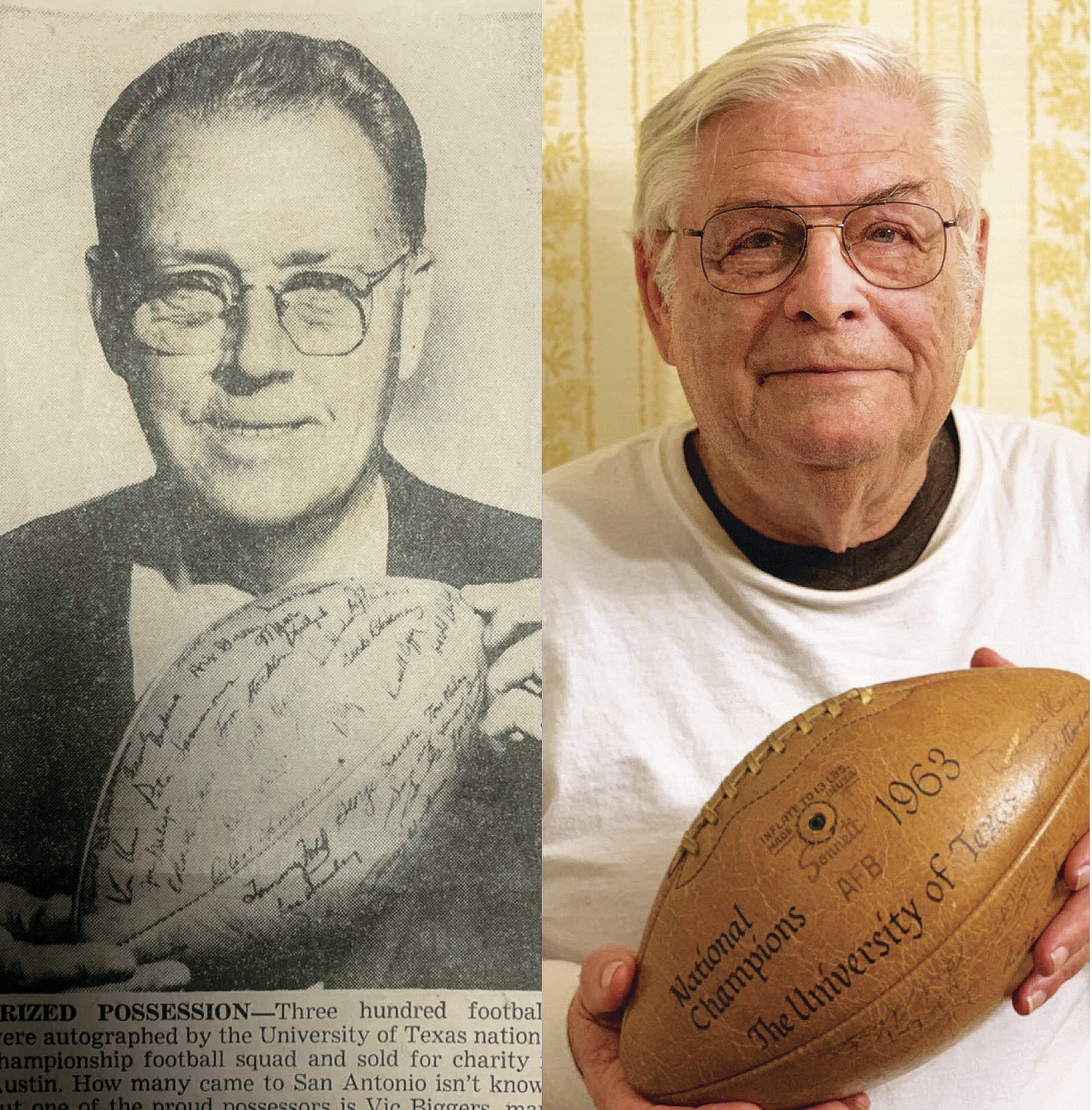
“When the Longhorns won the national championship in 1963, my dad, who graduated from UT that same year, bought one of just 300 footballs which were passed around and signed by each player. He gifted that ball to his father, which then ended up being featured in the local San Antonio newspaper. I now have that ball and the news clipping.”
—Richmond E. Meier, BBA ’92
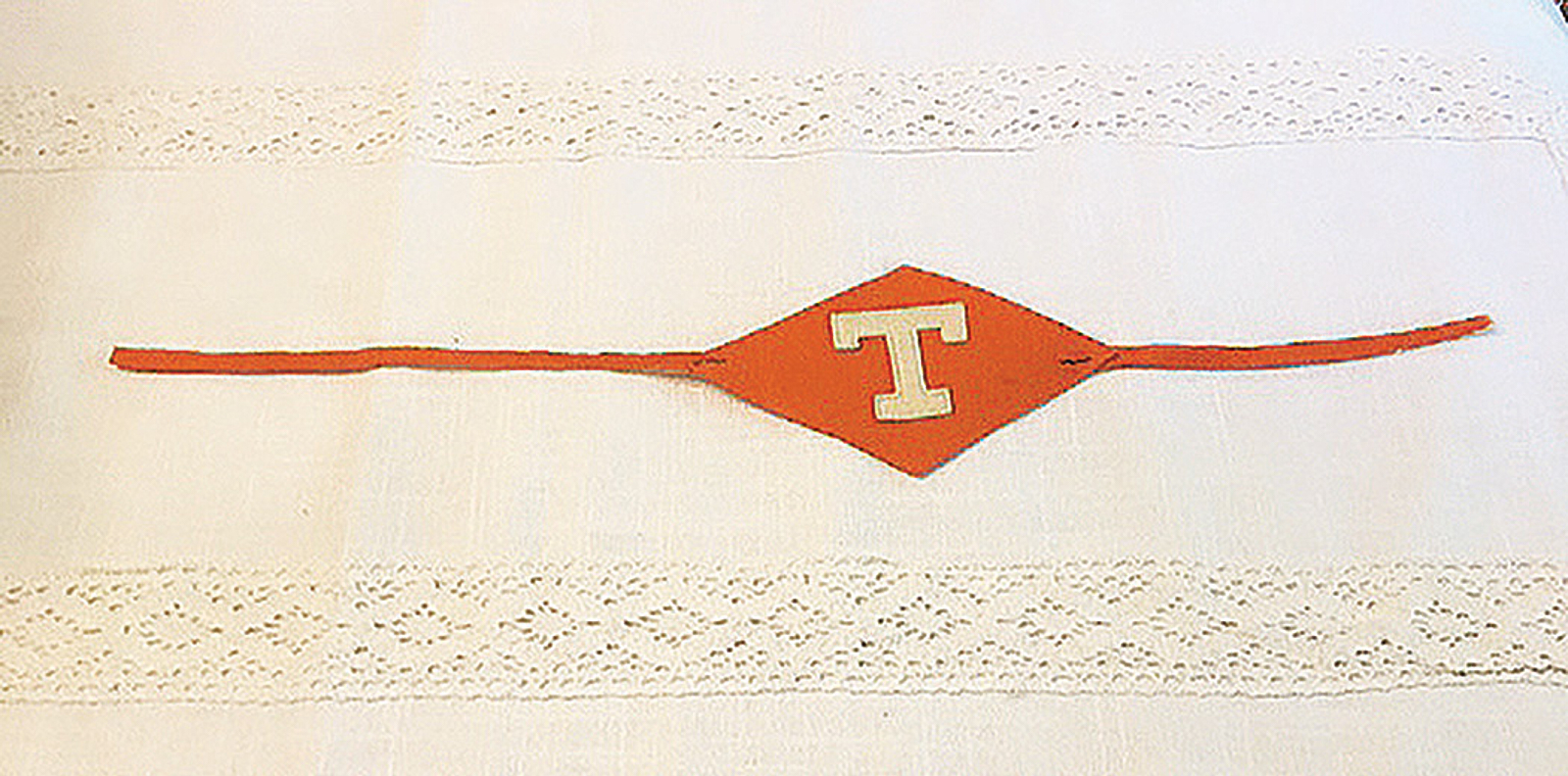
“I have kept this little orange felt armband that my mother, Alice Mackie Scott, wore during her days as a student at UT Austin around 1918. She married another UT student, Frederic Godfrey Tacquard, and there are now four generations of the Tacquard family who attended UT Austin.” —Eleanor Tacquard Otto, BA ’45, MA ’48, Life Member
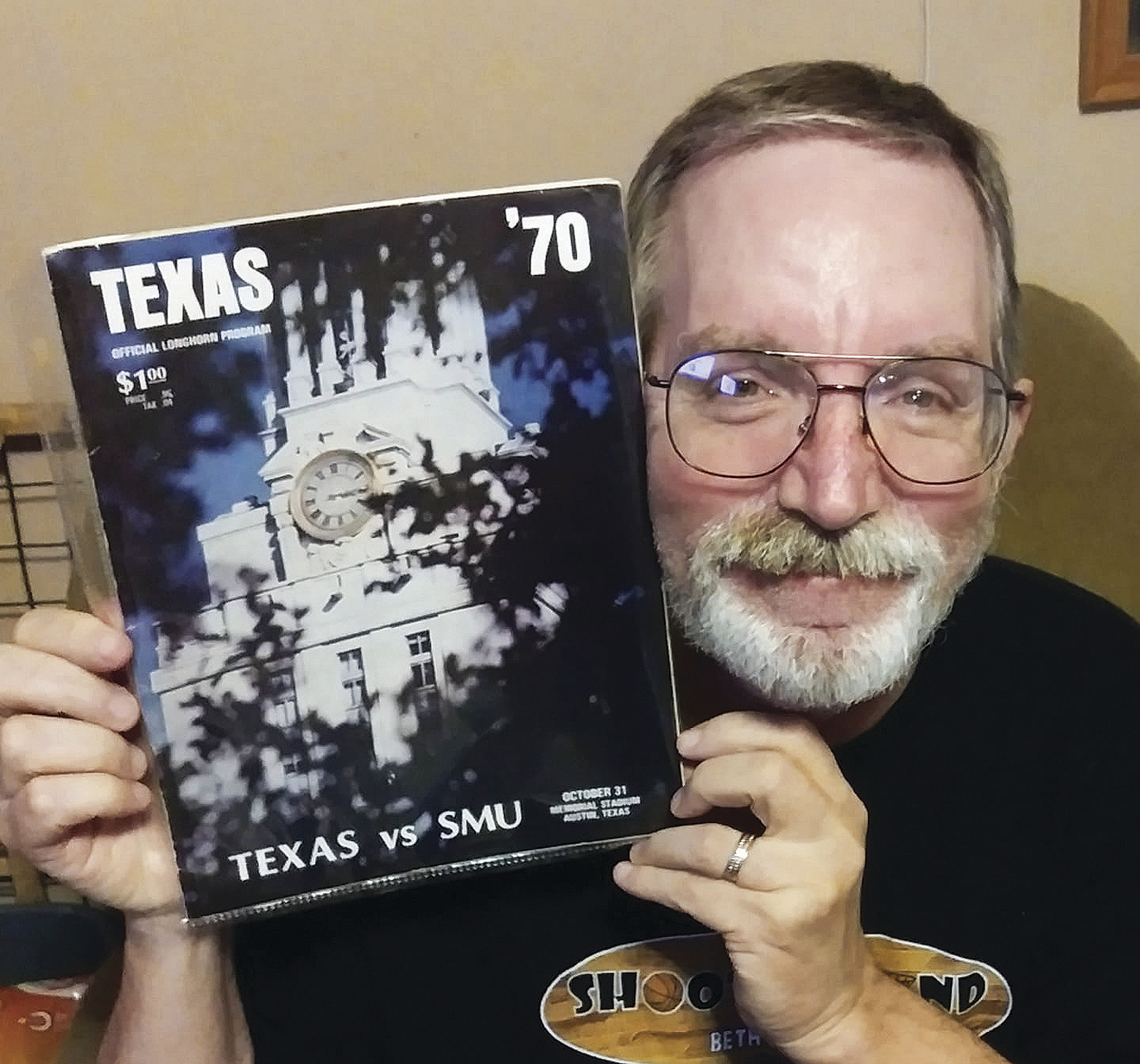
“I attended my first game at Memorial Stadium on Oct. 31, 1970, against SMU, and got my program signed by Happy Feller, Cotton Speyrer, and Freddie Steinmark. Six months later, our house caught fire and the program was destroyed. In August of 2019, with the 50th anniversary of that game one year away, I got on eBay to see if someone had one. Sure enough, there was one for sale and reasonably priced. I bought it.”
— Ronn Rowland, BJ ’96, Life Member
Credit: Matt Wright-Steel






